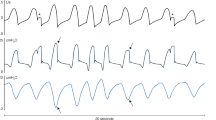Summary
Transient stop of respiration in exspiratory position can be produced in cats by intravenous injection of chlorpromazine, promethazine, and diethazine. The effect is dependend on the velocity of injection and on the concentration of the injected solution. Furthermore, it is most powerfull after administration into the arteria pulmonalis, but cannot be recognised after injection into the vena pulmonalis or into the bulbus aortae. It is abolished by vagotomia, but not by cooling both vagi to 6°C. Records of afferent vagal impulses at this temperature don't provide evidence for activation of lung stretch receptors. The alterations of blood pressure in the arteria et vena pulmonalis develop slowly and are only small. Therefore the chemosensible pulmonary vascular receptors are supposed to be chiefly involved in the reflectory stop of respiration after chlorpromazine, promethazine, and diethazine.
Similar content being viewed by others
Literatur
Aviado, D. M., R. G. Pontius and T. H. Li: The mechanism of apnea following intravenous injection of various antihistaminic compounds; its relation to their chemical structure. J. Pharmacol. exp. Ther. 99, 425–431 (1950).
Aviado, D. M., and C. F. Schmidt: Reflexes from stretch receptors in blood vessels, heart, and lungs. Physiol. Rev. 35, 247–300 (1955).
Barer, E. R., and E. Nuser: The part played by bronchial muscles in bronchial reflexes. Brit. J. Pharmacol. 8, 315–320 (1953).
Bucher, K.: Atmungshemmung durch niedrigen Blutdruck, II. Mitteilung. Helv. physiol. pharmacol. Acta 4, 77–81 (1946).
Dawes, G. S., and J. H. Comroe jr.: Chemoreflexes from the heart and lungs. Physiol. Rev. 34, 167–201 (1954).
Dawes, G. S., and F. N. Fastier: Reflex actions of some isothiourea derivates on circulation and respiration. Brit. J. Pharmacol. 5, 323–334 (1950).
Dawes, G. S., J. C. Mott and J. G. Widdicombe: Respiratory and cardiovascular reflexes from the heart and lungs. J. Physiol. (Lond.) 115, 258–291 (1951).
Feldmann, S., and D. P. Kidron: Experimental studies with chlorpromazine. Effect on cerebrospinal fluid pressure, blood pressure, respiration, and pial vessel diameter in the cat. Arch. int. Pharmacodyn. 111, 70–85 (1957).
Jones, J. V.: The nature of the pulmonary receptors excited by antihistaminics. Brit. J. Pharmacol. 7, 450–454 (1952).
Kreppel, E.: Untersuchungen über den Einfluß der Phenothiazine auf sensible Organrezeptoren. Arch. int. Pharmacodyn. 112, 20–25 (1957).
Maškowskij, M. D., S. S. Libermann u. A. I. Poležaeva: Zur Pharmakologie von Aminazin. Farmakol. i Toksikol. 18, 14–22 (1955).
Paintal, A. S.: Impulses in vagal afferent fibres from specific pulmonary deflation receptors. The response of these receptors to phenyldiguanide, potato starch, 5-hydroxytryptamine, and nicotine and their role in respiratory and cardiovascular reflexes. Quart. J. exp. Physiol. 40, 89–111 (1955).
Paintal, A. S.: The location and exitation of pulmonary deflation receptors by chemical substances. Quart. J. exp. Physiol. 42, 56–71 (1957).
Renzetti, jr., and W. R. Paget: The acute respiratory effects of chlorpromazine in man. J. Lab. clin. Med. 50, 400–409 (1957).
Weidmann, H., B. Berde u. K. Bucher: Die Lage der vagalen Dehnungsrezeptoren in der Lunge. Helv. physiol. pharmacol. Acta 7, 476–481 (1949).
Whitteridge, D.: Afferent nerve fibres from the heart and lungs in the cervical vagus. J. Physiol. (Lond.) 107, 496–512 (1948).
Widdicombe, J. G.: (1) Receptors in the trachea and bronchi of the cat. J. Physiol. (Lond.) 123, 71–104 (1954).
Widdicombe, J. G.: (2) Respiratory reflexes excited by inflation of the lungs. J. Physiol. (Lond.) 123, 105–115 (1954).
Widdicombe, J. G.: (3) The site of pulmonary stretch receptors in the cat. J. Physiol. (Lond.) 125, 336–351 (1954).
Winder, C. V., and R. W. Thomas: Cardiovascular and respiratory effects of the antihistamine agent, β-dimethylaminoethyl benzylhydryl ether hydrochloride (benadryl hydrochloride). J. Pharmacol. exp. Ther. 91, 1–14 (1947).
Zipf, H. F., u. P. Reichertz: Darstellung der totalen und reversiblen Endoanaesthesie der Lungendehnungsreceptoren durch Wirkung/Zeit-Kurven. Naunyn-Schmiedeberg's Arch. exp. Path. Pharmak. 231, 96–110 (1957).
Author information
Authors and Affiliations
Additional information
Herrn Professor Jarisch zum 70. Geburtstag gewidmet.
Mit 5 Textabbildungen
Rights and permissions
About this article
Cite this article
Wellhöner, HH., Hartmann, H. & Hauschild, F. Zum Mechanismus des reflektorischen Atemstillstandes nach intravenöser Injektion von Chlorpromazin. Naunyn - Schmiedebergs Arch 240, 224–233 (1960). https://doi.org/10.1007/BF00244840
Received:
Issue Date:
DOI: https://doi.org/10.1007/BF00244840




